Target Information
| Target General Information | Top | |||||
|---|---|---|---|---|---|---|
| Target ID |
T31989
(Former ID: TTDC00058)
|
|||||
| Target Name |
Sphingosine kinase 2 (SPHK2)
|
|||||
| Synonyms |
SPK 2; SK 2
Click to Show/Hide
|
|||||
| Gene Name |
SPHK2
|
|||||
| Target Type |
Clinical trial target
|
[1] | ||||
| Disease | [+] 1 Target-related Diseases | + | ||||
| 1 | Solid tumour/cancer [ICD-11: 2A00-2F9Z] | |||||
| Function |
Acts on D-erythro-dihydrosphingosine, D-erythro-sphingosine and L-threo-dihydrosphingosine. Binds phosphoinositides. Catalyzes the phosphorylation of sphingosine to form sphingosine 1-phosphate (SPP), a lipid mediator with both intra- and extracellular functions.
Click to Show/Hide
|
|||||
| BioChemical Class |
Kinase
|
|||||
| UniProt ID | ||||||
| EC Number |
EC 2.7.1.91
|
|||||
| Sequence |
MNGHLEAEEQQDQRPDQELTGSWGHGPRSTLVRAKAMAPPPPPLAASTPLLHGEFGSYPA
RGPRFALTLTSQALHIQRLRPKPEARPRGGLVPLAEVSGCCTLRSRSPSDSAAYFCIYTY PRGRRGARRRATRTFRADGAATYEENRAEAQRWATALTCLLRGLPLPGDGEITPDLLPRP PRLLLLVNPFGGRGLAWQWCKNHVLPMISEAGLSFNLIQTERQNHARELVQGLSLSEWDG IVTVSGDGLLHEVLNGLLDRPDWEEAVKMPVGILPCGSGNALAGAVNQHGGFEPALGLDL LLNCSLLLCRGGGHPLDLLSVTLASGSRCFSFLSVAWGFVSDVDIQSERFRALGSARFTL GTVLGLATLHTYRGRLSYLPATVEPASPTPAHSLPRAKSELTLTPDPAPPMAHSPLHRSV SDLPLPLPQPALASPGSPEPLPILSLNGGGPELAGDWGGAGDAPLSPDPLLSSPPGSPKA ALHSPVSEGAPVIPPSSGLPLPTPDARVGASTCGPPDHLLPPLGTPLPPDWVTLEGDFVL MLAISPSHLGADLVAAPHARFDDGLVHLCWVRSGISRAALLRLFLAMERGSHFSLGCPQL GYAAARAFRLEPLTPRGVLTVDGEQVEYGPLQAQMHPGIGTLLTGPPGCPGREP Click to Show/Hide
|
|||||
| 3D Structure | Click to Show 3D Structure of This Target | AlphaFold | ||||
| HIT2.0 ID | T23UM3 | |||||
| Drugs and Modes of Action | Top | |||||
|---|---|---|---|---|---|---|
| Clinical Trial Drug(s) | [+] 1 Clinical Trial Drugs | + | ||||
| 1 | ABC294640 | Drug Info | Phase 3 | Advanced solid tumour | [2], [3] | |
| Mode of Action | [+] 2 Modes of Action | + | ||||
| Modulator | [+] 1 Modulator drugs | + | ||||
| 1 | ABC294640 | Drug Info | [1], [4], [5] | |||
| Inhibitor | [+] 6 Inhibitor drugs | + | ||||
| 1 | (R)-2-amino-3-(4-octylphenylamino)propan-1-ol | Drug Info | [6] | |||
| 2 | (R)-2-amino-4-hydroxy-N-(4-octylphenyl)butanamide | Drug Info | [6] | |||
| 3 | (S)-2-amino-4-hydroxy-N-(4-octylphenyl)butanamide | Drug Info | [6] | |||
| 4 | (S)-2-amino-6-hydroxy-N-(4-octylphenyl)hexanamide | Drug Info | [6] | |||
| 5 | DIMETHYLSPINGOSINE | Drug Info | [7] | |||
| 6 | ROMe | Drug Info | [8] | |||
| Cell-based Target Expression Variations | Top | |||||
|---|---|---|---|---|---|---|
| Cell-based Target Expression Variations | ||||||
| Different Human System Profiles of Target | Top |
|---|---|
|
Human Similarity Proteins
of target is determined by comparing the sequence similarity of all human proteins with the target based on BLAST. The similarity proteins for a target are defined as the proteins with E-value < 0.005 and outside the protein families of the target.
A target that has fewer human similarity proteins outside its family is commonly regarded to possess a greater capacity to avoid undesired interactions and thus increase the possibility of finding successful drugs
(Brief Bioinform, 21: 649-662, 2020).
Human Pathway Affiliation
of target is determined by the life-essential pathways provided on KEGG database. The target-affiliated pathways were defined based on the following two criteria (a) the pathways of the studied target should be life-essential for both healthy individuals and patients, and (b) the studied target should occupy an upstream position in the pathways and therefore had the ability to regulate biological function.
Targets involved in a fewer pathways have greater likelihood to be successfully developed, while those associated with more human pathways increase the chance of undesirable interferences with other human processes
(Pharmacol Rev, 58: 259-279, 2006).
Biological Network Descriptors
of target is determined based on a human protein-protein interactions (PPI) network consisting of 9,309 proteins and 52,713 PPIs, which were with a high confidence score of ≥ 0.95 collected from STRING database.
The network properties of targets based on protein-protein interactions (PPIs) have been widely adopted for the assessment of target’s druggability. Proteins with high node degree tend to have a high impact on network function through multiple interactions, while proteins with high betweenness centrality are regarded to be central for communication in interaction networks and regulate the flow of signaling information
(Front Pharmacol, 9, 1245, 2018;
Curr Opin Struct Biol. 44:134-142, 2017).
Human Similarity Proteins
Human Pathway Affiliation
Biological Network Descriptors
|
|
|
There is no similarity protein (E value < 0.005) for this target
|
| KEGG Pathway | Pathway ID | Affiliated Target | Pathway Map |
|---|---|---|---|
| Sphingolipid metabolism | hsa00600 | Affiliated Target |

|
| Class: Metabolism => Lipid metabolism | Pathway Hierarchy | ||
| Calcium signaling pathway | hsa04020 | Affiliated Target |
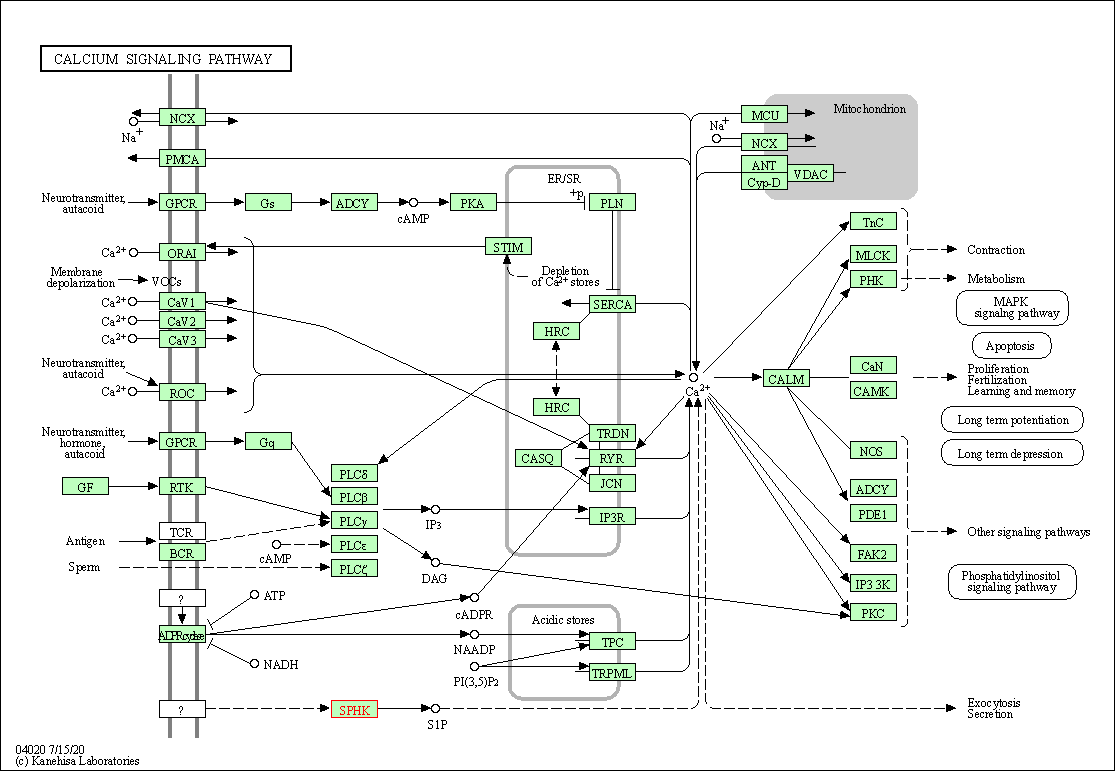
|
| Class: Environmental Information Processing => Signal transduction | Pathway Hierarchy | ||
| Sphingolipid signaling pathway | hsa04071 | Affiliated Target |
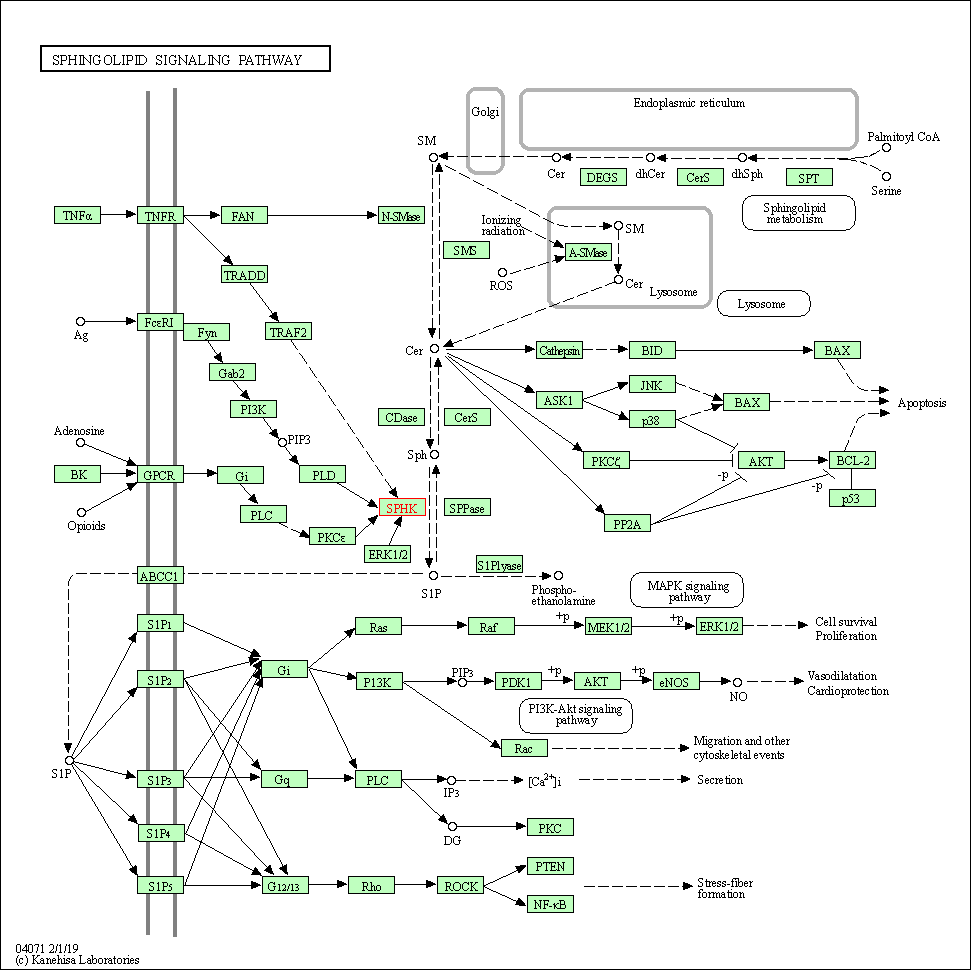
|
| Class: Environmental Information Processing => Signal transduction | Pathway Hierarchy | ||
| Phospholipase D signaling pathway | hsa04072 | Affiliated Target |
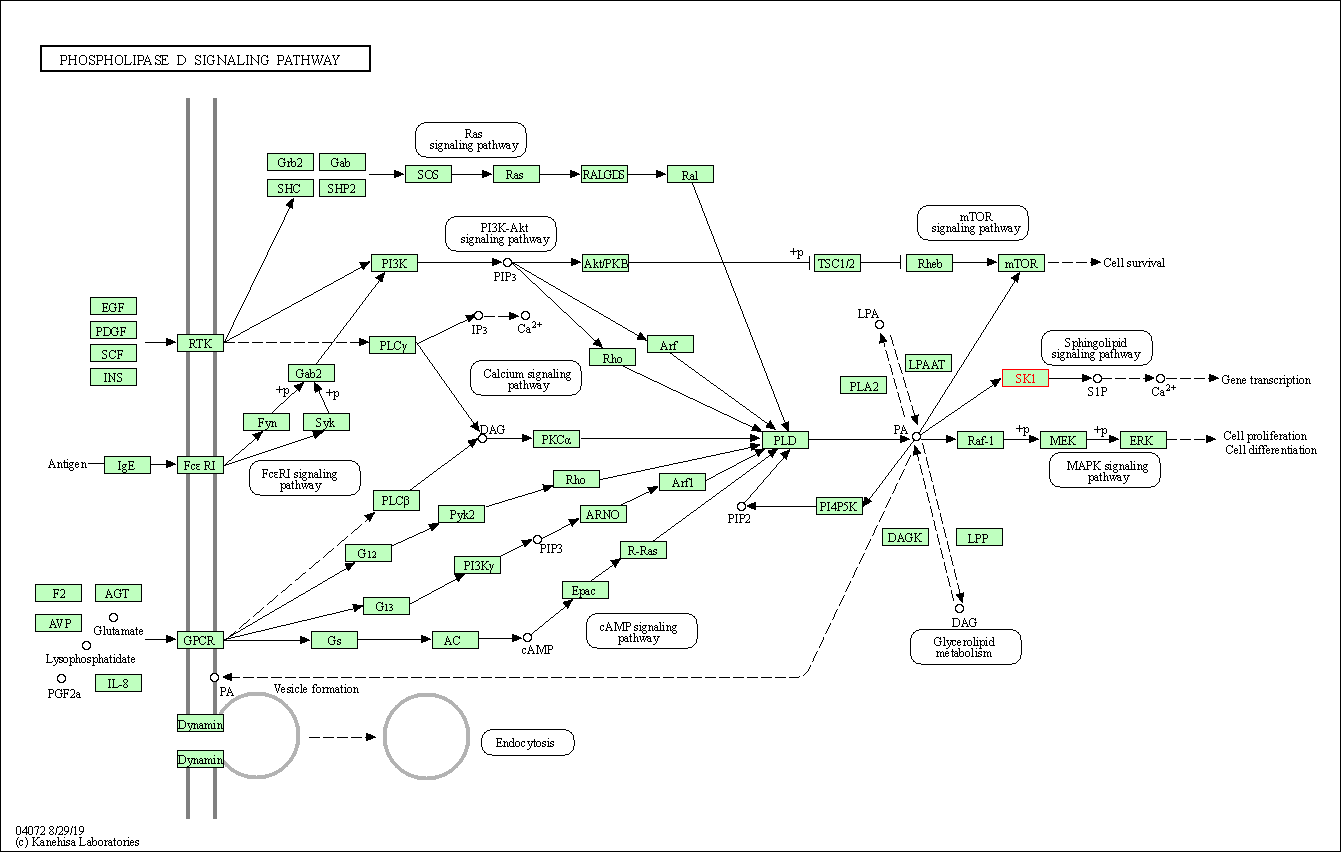
|
| Class: Environmental Information Processing => Signal transduction | Pathway Hierarchy | ||
| VEGF signaling pathway | hsa04370 | Affiliated Target |
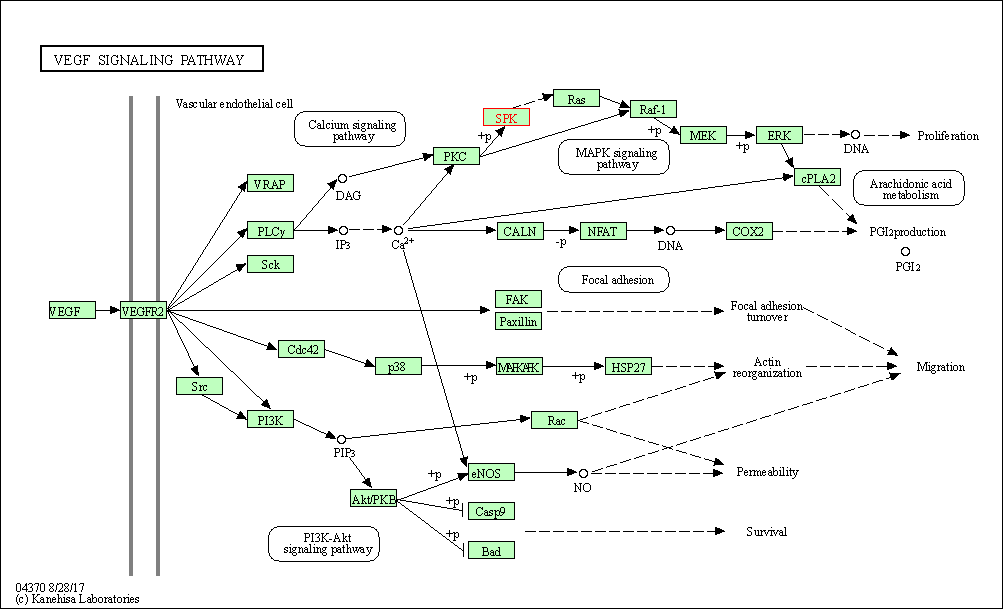
|
| Class: Environmental Information Processing => Signal transduction | Pathway Hierarchy | ||
| Apelin signaling pathway | hsa04371 | Affiliated Target |

|
| Class: Environmental Information Processing => Signal transduction | Pathway Hierarchy | ||
| Fc gamma R-mediated phagocytosis | hsa04666 | Affiliated Target |
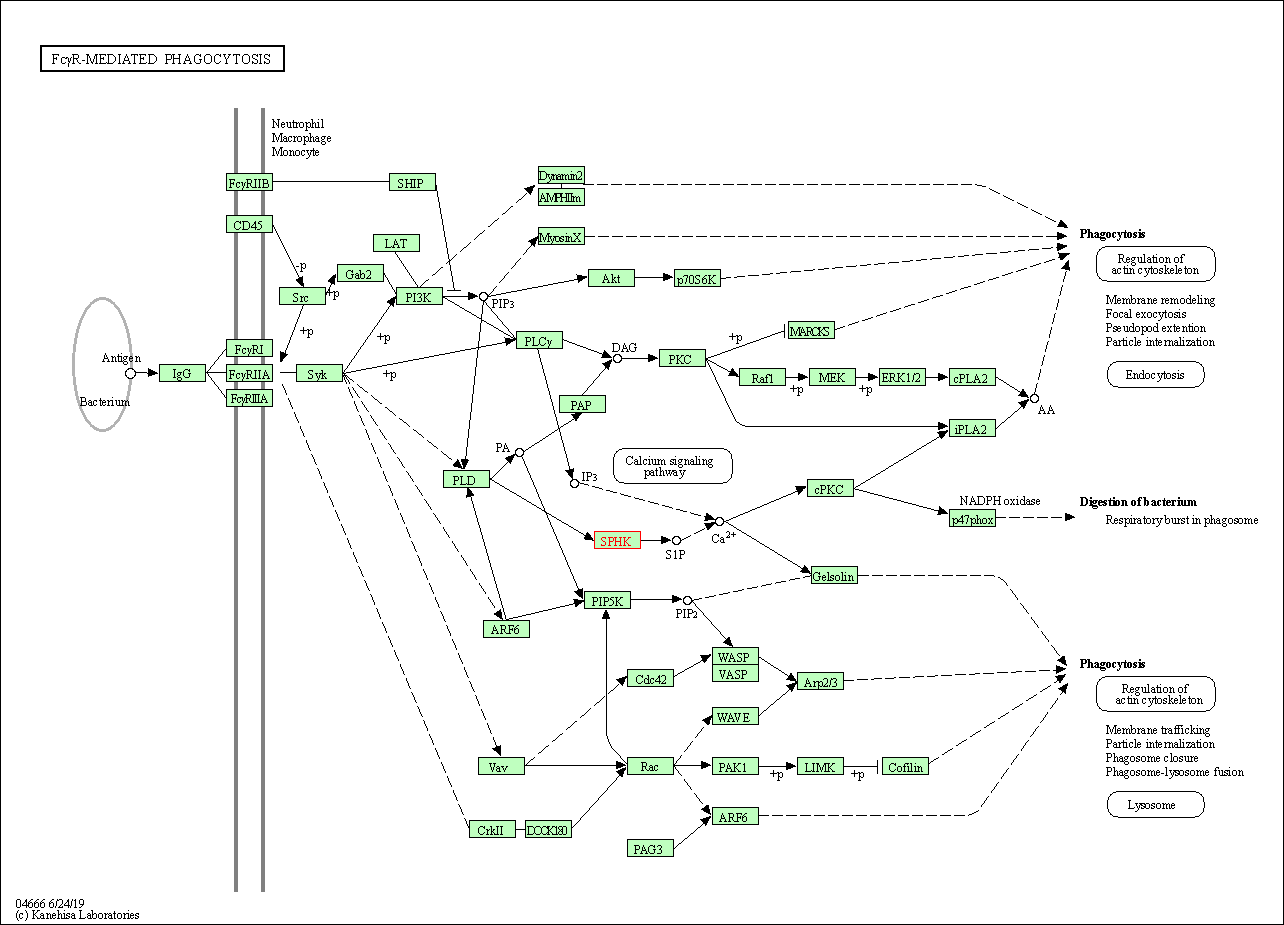
|
| Class: Organismal Systems => Immune system | Pathway Hierarchy | ||
| Click to Show/Hide the Information of Affiliated Human Pathways | |||
| Degree | 19 | Degree centrality | 2.04E-03 | Betweenness centrality | 3.73E-03 |
|---|---|---|---|---|---|
| Closeness centrality | 2.11E-01 | Radiality | 1.37E+01 | Clustering coefficient | 2.40E-01 |
| Neighborhood connectivity | 1.45E+01 | Topological coefficient | 1.15E-01 | Eccentricity | 11 |
| Download | Click to Download the Full PPI Network of This Target | ||||
| Chemical Structure based Activity Landscape of Target | Top |
|---|---|
| Drug Property Profile of Target | Top | |
|---|---|---|
| (1) Molecular Weight (mw) based Drug Clustering | (2) Octanol/Water Partition Coefficient (xlogp) based Drug Clustering | |
|
|
||
| (3) Hydrogen Bond Donor Count (hbonddonor) based Drug Clustering | (4) Hydrogen Bond Acceptor Count (hbondacc) based Drug Clustering | |
|
|
||
| (5) Rotatable Bond Count (rotbonds) based Drug Clustering | (6) Topological Polar Surface Area (polararea) based Drug Clustering | |
|
|
||
| "RO5" indicates the cutoff set by lipinski's rule of five; "D123AB" colored in GREEN denotes the no violation of any cutoff in lipinski's rule of five; "D123AB" colored in PURPLE refers to the violation of only one cutoff in lipinski's rule of five; "D123AB" colored in BLACK represents the violation of more than one cutoffs in lipinski's rule of five | ||
| Target Poor or Non Binders | Top | |||||
|---|---|---|---|---|---|---|
| Target Poor or Non Binders | ||||||
| Target Affiliated Biological Pathways | Top | |||||
|---|---|---|---|---|---|---|
| BioCyc | [+] 1 BioCyc Pathways | + | ||||
| 1 | Sphingosine and sphingosine-1-phosphate metabolism | |||||
| KEGG Pathway | [+] 7 KEGG Pathways | + | ||||
| 1 | Sphingolipid metabolism | |||||
| 2 | Metabolic pathways | |||||
| 3 | Calcium signaling pathway | |||||
| 4 | Sphingolipid signaling pathway | |||||
| 5 | VEGF signaling pathway | |||||
| 6 | Fc gamma R-mediated phagocytosis | |||||
| 7 | Tuberculosis | |||||
| Panther Pathway | [+] 2 Panther Pathways | + | ||||
| 1 | Angiogenesis | |||||
| 2 | VEGF signaling pathway | |||||
| Pathwhiz Pathway | [+] 1 Pathwhiz Pathways | + | ||||
| 1 | Sphingolipid Metabolism | |||||
| PID Pathway | [+] 3 PID Pathways | + | ||||
| 1 | IL12-mediated signaling events | |||||
| 2 | Ceramide signaling pathway | |||||
| 3 | Sphingosine 1-phosphate (S1P) pathway | |||||
| Reactome | [+] 1 Reactome Pathways | + | ||||
| 1 | Sphingolipid de novo biosynthesis | |||||
| WikiPathways | [+] 2 WikiPathways | + | ||||
| 1 | Signal Transduction of S1P Receptor | |||||
| 2 | Sphingolipid Metabolism | |||||
| Target-Related Models and Studies | Top | |||||
|---|---|---|---|---|---|---|
| Target Validation | ||||||
| References | Top | |||||
|---|---|---|---|---|---|---|
| REF 1 | Targeting the sphingosine-1-phosphate axis in cancer, inflammation and beyond. Nat Rev Drug Discov. 2013 Sep;12(9):688-702. | |||||
| REF 2 | URL: http://www.guidetopharmacology.org Nucleic Acids Res. 2015 Oct 12. pii: gkv1037. The IUPHAR/BPS Guide to PHARMACOLOGY in 2016: towards curated quantitative interactions between 1300 protein targets and 6000 ligands. (Ligand id: 6624). | |||||
| REF 3 | ClinicalTrials.gov (NCT02229981) An Early-Phase Clinical Trial Evaluating ABC294640 in Patients With Refractory/Relapsed Diffuse Large B-cell Lymphoma. U.S. National Institutes of Health. | |||||
| REF 4 | Targeting sphingosine kinase 2 (SphK2) by ABC294640 inhibits colorectal cancer cell growth in vitro and in vivo.J Exp Clin Cancer Res.2015 Sep 4;34:94. | |||||
| REF 5 | The roles of sphingosine kinases 1 and 2 in regulating the Warburg effect in prostate cancer cells.Cell Signal.2013 Apr;25(4):1011-7. | |||||
| REF 6 | Discovery of novel sphingosine kinase 1 inhibitors. Bioorg Med Chem Lett. 2009 Nov 1;19(21):6119-21. | |||||
| REF 7 | Synthesis and evaluation of sphingosine analogues as inhibitors of sphingosine kinases. J Med Chem. 2009 Jun 25;52(12):3618-26. | |||||
| REF 8 | (R)-FTY720 methyl ether is a specific sphingosine kinase 2 inhibitor: Effect on sphingosine kinase 2 expression in HEK 293 cells and actin rearrangement and survival of MCF-7 breast cancer cells. Cell Signal. 2011 Oct;23(10):1590-5. | |||||
If You Find Any Error in Data or Bug in Web Service, Please Kindly Report It to Dr. Zhou and Dr. Zhang.

